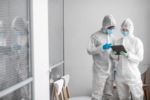The main characteristics of a cleanroom are:
- Air control and filtration.
Air is a carrier of particles—and therefore of dust, microbes, and aerosol suspensions—and represents a potential risk factor in controlled environments. For this reason, it is essential to manage the ventilation system using an HVAC (Heating, Ventilation, and Air Conditioning) system that allows the maintenance of a constant temperature regardless of external climatic variations and reduces the risk of contamination due to humidity. To ensure clean and particle-free air, the ventilation system must also be equipped with suitable filtration using HEPA (High Efficiency Particulate Air) filters, which are designed to capture up to 99.999% of particles larger than 0.3 microns. - Airflow types.
In unidirectional (laminar flow) cleanrooms, filtered air is distributed evenly across the room through parallel lines to avoid particle recirculation and to direct them towards extraction zones. In turbulent flow rooms, on the other hand, air is mixed inside the room, creating a swirling movement. This second type is less expensive to build and maintain, suitable for larger and more complex configurations, but provides a lower cleanliness level (ISO Class 8–9) compared to laminar flow rooms. - Environmental parameter control. Temperature, humidity, pressure, and airflow velocity must be maintained within precise ranges to ensure stable and safe operating conditions.
- Materials and finishes.
Materials used in cleanrooms must be easy to clean, disinfect, and sterilize. Commonly used materials include high-pressure laminate (HPL), PVC, stainless steel, aluminum, epoxy resins, and linoleum. - Gowning and access.
Authorized personnel must wear specific clothing and protective equipment (coveralls, caps, goggles, masks, shoe covers) and follow strict gowning and access procedures to minimize the introduction of contaminants. - Monitoring and control.
The cleanroom is equipped with a continuous monitoring system for environmental parameters and operational conditions, enabling the detection of any anomalies and timely intervention.


